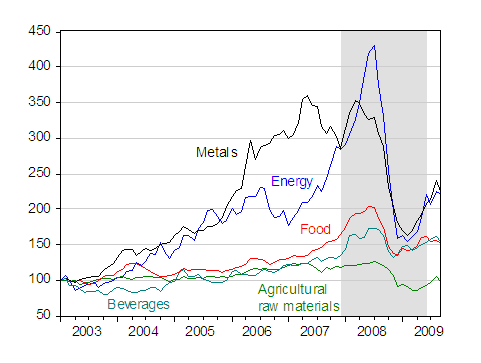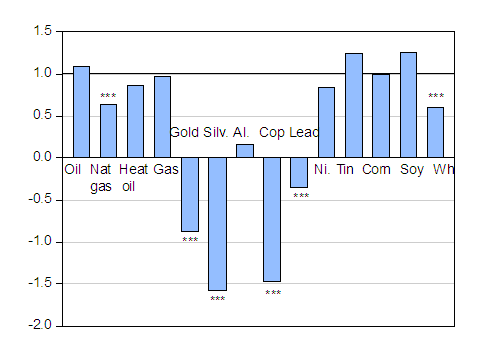As commodity prices start rising again — at least some — the question of whether futures are useful indicators seems relevant. Figure 1 shows the IMF commodity price indices, as reported in the October World Economic Outlook:

Figure 1: Commodity price indices for energy (blue), food (red), agricultural raw materials (green), metals (black) and beverages (teal). NBER defined recession shaded gray, assuming recession ends in 2009M06. Source: IMF, World Economic Outlook (October 2009), data for Chart 1.16.
In a previous set of papers, Oli Coibion, Michael LeBlanc and I examined the predictive power of energy futures post and paper.
In a new paper, Oli Coibion and I update our results regarding energy futures, and metal and agricultural commodities as well, through the end of August 2008, just before the financial crisis broke out in full force. From the paper:
This paper examines the relationship between spot and futures prices for commodities, including those for energy (crude oil, gasoline, heating oil markets and natural gas), precious and base metals (gold, silver, aluminum, copper, lead, nickel and tin), and agricultural commodities (corn, soybean and wheat). In particular, we examine whether futures prices are (1) an unbiased and/or (2) accurate predictor of subsequent spot prices. We find that while energy futures prices are generally unbiased predictors of future spot prices, there are certain notable exceptions. For both base and precious metals, the results are much less favorable to unbiasedness hypothesis. For precious metals and copper and lead, we strongly reject the null that β=1 at all three horizons. For the these other base metals, while we cannot reject that β=1, due to large standard errors. Finally, both corn and soybean futures have β close to 1, while wheat has β<1. Excepting oil and base metals, futures tend to outperform a random walk specification in out of sample forecasts.
The regression we run is:
st – st-k = β 0 + β 1 (f t|t-k – st-k) + ε t
Where st is the log spot price at time t, ft|t-k is the log futures price at time t-k that matures at time t. The resulting β coefficients at the three month horizons are displayed in Figure 2.

Figure 2: β1 coefficients, estimated via OLS. *** denotes significantly different from unity at the 1% level, using HAC robust standard errors. Source: Author’s calculations.
Despite the bias in futures, along a RMSE dimension, futures outperform a random walk for most commodities, except for base metals (the out of sample period is 03M01 to 08M07). That being said, the outperformance relative to a random walk is seldom statistically significant.
It would be interesting to also compare the difference between future price and spot price with the difference between (smoothed) future commodity volume (at the market clearing price) and (smoothed) recent commodity volume. I’m thinking about the idea that in some cases, future supply will also respond to the same predictive factors that drive the futures pricing or to the future pricing itself.
Can you break this down to see how much of this is futures prices just predicting that a rising, or falling trend will continue versus how well futures prices forecast a change in trend?
Arrow Debreu markets effisciency hypothesis confirmed?
Then should it be the case, the markets do not need intermediaries and they do.
Few questions please
Is there any inter relationship between steady interest rates rates and the behaviour of the panel members?
How good is the predictabilty of the futures vs spot prices when a set of participants has an overwhelming market shares of the futures? that is an Universe where there is a set of participants but few have the major weighing (could it be still defined as a general equilibrium providing competitive pricing?)
First, “…futures outperform a random walk…” but “the outperformance relative to a random walk is seldom statistically significant”: not a very rigorous way to write about statistical results! (Outperformance that isn’t statistically significant, isn’t.)
Second, surely this test really comes down to an evaluation of the liquidity available in the commodities markets, inasmuchas in the presence of sufficient liquidity the arbitrage opportunities represented by futures prices with predictive power would be eliminated….
Dr. D: There is an enormous literature differentiating between economic and statistical significance, and significance in terms of being able to make a profit (filter rules). In other papers (as opposed to blogposts), I have operationalized this concept. You might usefully apprise yourself of the distinctions as well.
as a rejoinder, I think that some economically significant magnitudes are still worth considering, even if statistically the distinction might not be there at conventional significance levels, e.g., 90%. See for instance the debate over the RMB misalignment, in various papers by myself, Cheung and Fujii.
When looking at prices patterns and transportation flows, there appears to be on obvious prices/ stocks gap (inventory? markets effisciency?paper profits?)
http://railfax.transmatch.com/
http://www.bloomberg.com/apps/cbuilder?ticker1=BDIY:IND
Doesn’t it depend on the extent to which oil is substitutable with cash alternatives? For example, one should never look to futures prices of currencies to predict future currency values, because the futures prices are locked by arbitrage that depends only on the interest differential and spot rate. Speculators will virtually never move the futures price outside the interest-arbitrage-determined price, so their views will not be reflected at all in the futures prices. For the same reason, one should never expect the price of gold in the futures market to contain any information about expectations for the future spot price of gold. Similar arbitrage considerations must surely reduce the information that oil futures provide as to expectations about the future movement of the spot price, though probably not as strong as for gold or currencies. In other words, your results are what one might expect.
Are these relationships stable over time? Your paper covers 1999 to 2004, but I did not see comparable “Beta ones”. That may be my fault, but I still didn’t see it. And what about other stormy time periods, like the 70s & 80s for oil and gold, the 80s for food crops.
Menzie, I completely agree that the world of economics plays very loose with statistics concepts, and thus it would seem all the more imperative to say what you mean and mean what you say and provide full context for your discussion: simply tossing out an observation, particularly an observation of something that is and has been studied and analyzed thoroughly in many different contexts, is not enlightening!
In the present case, you give no indication whether you are looking at this from a perspective of significance to the macro picture, financial markets, profit opportunities, or perhaps yet another rejoinder vis a vis the Bush adminstation….
Menzie,
Interesting post–something I’ve been meaning to reinvestigate myself for a long time now.
If it’s easy to do, I would I’d be curious about statistics on
1) the average value of the dependent variable in comparison the average value of the explanatory variable.
2) joint tests for alpha=0 and beta=1
As a follow up, I might play around with regression models like:
s(t) – f(t|t-k) = a + s(t-k) + ??? + error
That is, under what circumstances do risk premia appear more negative or more positive, and do these relate to other economic phenomena (the ???). These other phenomena might be indicators of stock market or other kinds of volatility.
spencer: In our previous paper on energy futures, we assessed a period wherein prices both rose and fell. Some of the details are different, but I don’t think they are drastically different overall.
ppcm: I don’t interpret the inability to statistically outperform a random walk as ncessarily evidence in favor of the EMH — see Jeff Frankel’s “Zen of Modern Macroeconometrics” for my reasoning. For me (I can’t speak for my coauthor), the question is a narrower one of whether futures have predictive content greater than the no-change alternative.
don: I agree futures are tied down by interest rates or cost of storage; and covered interest parity does typically hold for currencies. But uncovered interest parity does not (at least insofar as we can test). Similarly one can still ask if futures are unbiased predictors of future spot prices, even if arbitrage holds.
Dr. D: The title of the paper is “The predictive content of commodity futures”. We are looking at it from an econometric perspective, as I have done here, here, here, and here.
By the way, regarding your point:
in my opinion represents a fundamental misunderstanding of the efficient markets hypothesis. If agents are risk neutral, and expectations are rational in the sense of being being unbiased, then in fact (after taking into account interest rates, or cost of storage, etc., depending on the context), the future rate should be an unbiased predictor of the future spot rate.
Menzie
in my opinion represents a fundamental misunderstanding of the efficient markets hypothesis. If agents are risk neutral, and expectations are rational in the sense of being being unbiased, then in fact (after taking into account interest rates, or cost of storage, etc., depending on the context), the future rate should be an unbiased predictor of the future spot rate.
That is fine! As long as a preset of markets participants do not introduce an axiom of dictartorship as a mean to build up a consensus on pricing.
But isn’t the risk premium the interesting part of this analysis?
While Dr. D used the word “liquidity” I think a reasonable interpretation of that might be “risk aversion.” With risk aversion, there is a risk premium that depends on the covariance of the spot/future differential and wealth.
This article by an outside commodities expert in the FT gives some insight into the use of oil futures as benchmarks for pricing oil.
http://www.ft.com/cms/s/0/8bc358bc-c893-11de-8f9d-00144feabdc0.html
There have been a lot of abusive populists in the US taking advantage of ordinary people’s ignorance about oil markets and promising in their political campaigns to bring down gasoline prices by cracking down on WTI futures trading.
Meanwhile, Saudi Arabia has stopped using the WTI index as a price benchmark for its sales to the US, because the reality is that WTI has been pricing oil lower than the Saudis can get elsewhere, because a lot of the oil running through Cushing comes from US and Canadian producers who are more or less locked into selling locally, and because of the large storage capacity at Cushing. WTI has never been used as a benchmark outside the Americas.